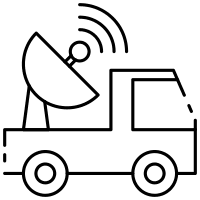
In the not-so-distant past, broadcasting a live video feed from anywhere other than a hyper-controlled studio environment was complicated. It would require expensive satellite trucks operated by specialized contractors who would drive their truck to your location costing milage, labor, connection services, redundant connection services – the list could pile on.
But what if you don’t have the $7,500 (sometimes up to $15,000) in your budget for every remote show? Before you might have just had to settle with a simple, defeating “NO. It’s not going to happen.” To solve this problem of high cost and entry barriers for small productions, the industry has evolved to use the ever-improving technology of cellular data connections.

PLANNING YOUR LIVESTREAM INTERNET WORKFLOW
USING HARDLINE INTERNET FOR YOUR BROADCAST
Now, I know what you might be thinking: “I can’t trust any internet if I’m not hard-lined into it with an ethernet cable!” The truth is you’re actually on to something. It’s true that when all else is equal, nothing beats a hardline.
Depending on your location, most conventional Internet Service Providers (ISPs) are actually equipped to provide temporary commercial internet installs, including outdoor public spaces. Where an ISP has the infrastructure to provide residential or commercial customers with a modem service, there are often ‘nodes’ a technician is able to tap into a new line for service. These may be in plain sight under a cover in the sidewalk, or a pedestal behind a bush.
Often, if you’re lucky, that bush is exactly where you want to place your static camera or production tent to stream from! A tech would meet you on-site, run coaxial cable to your service location from a node in the ground, and provide a modem that they test for you right in front of you on the side of the public street.
This is always a route to consider, especially if you have a high-profile production on-site where you are capable of encoding your stream from a central location with a few days of prep time. Lookup ISPs in your city (think Comcast/Xfinity, COX, Century Link, Spectrum, etc.) and give them a call to chat about your ideas and needs (with plenty of time in advance! We recommend starting this conversation NO LATER than 1 month in advance).
This type of service varies wildly across the country, but in some cities with established infrastructures, you may expect to pay just a couple hundred bucks for stellar high-speed internet (I’m looking at you, Chattanooga, Tennessee!). Obviously this is a massive difference in price from a satellite connection that still gives you peace of mind.
So is hardline internet your only option? No!
CELLULAR DATA FOR YOUR LIVESTREAM INTERNET CONNECTION
Of course, you may not be so lucky. Maybe you need to livestream near a lake that is out of town. Or, you are filming action that doesn’t stay put, like a cyclist or runner where a cable leash is impractical. In this case, setting yourself up with a cellular connection may be your only solution.
How do you get a cellular modem connection? Let’s talk about a couple options:
SIMPLE Single Modem CELLULAR CONNECTIONS
Obviously, the easiest and most accessible modem is right in your pocket. Most modern cellphones have appropriate hardware to connect to 4G LTE networks, if not the new and improved 5G that has been rolling out in some cities. With close connection to a good cell tower, this 4G LTE might provide up to a 15Mbps upload which is plenty for many applications. If you have a computer setup to stream with an encoding software such as OBS, Wirecast, or Livestream Studio, simply tether your WiFi to your phone and you’re on your way! This would be the same concept as connecting to a dedicated WiFi hotspot, such as a Verizon Wireless MiFi, or the new, super rad Netgear Nighthawk 5G Mobile Hotspot (which even comes with an ethernet port to connect your computer to. Super handy!).
If you really want to run thin, the built-in camera on new iPhones truly can rival a ton of other stand-alone cameras out there. Fun fact, an iPhone XS Max on a gimble using its internal camera and SIM connection is what we used to stream Chris Nikic’s famed IRONMAN finish live, where our cameraman ran 2 miles with him into the finish line. No sat trucks, heavy cameras, rigging equipment, vehicles, or anything–just a guy with an iPhone and his two feet. This video has garnered 2.8 million views at the time of writing!
EXPAND WITH MULTIPLE CELLULAR CONNECTIONS
If you want to look into more professional and robust ways to step up your internet connection above your iPhone, we can start to look into bonded cellular connections. Bonding protocol (short for “Bandwidth ON Demand INteroperability Group”) or link aggregation, is a networking tool to combine multiple network connections in parallel in order to increase throughput.
What does this mean?
Imagine you get to your streaming site and you find your cell phone on Verizon Wireless achieves a maximum 2Mbps x 2Mbps. Your buddy has AT&T and he gets 2Mbps x 2Mbps. Each on their own, you may not feel comfortable streaming your show via tethered WiFi.
“Why can’t I just use both?!” You may exclaim.
Bonded networks allow you to do just that! More than a simple failover (switching from one cellular connection to other in the case of failure), a bonded service actively uses all connected modems at the same time allowing them to actively ‘pick up the slack’ from each other as conditions and throughput demands change. There are a lot of complicated idiosyncrasies involved, but under ideal conditions in this particular scenario, this may provide up to 4Mbps x 4Mbps with less latency, less jitter, and better server response time. All good news for us broadcasters!
Now you can’t exactly connect your laptop to your two iPhones at the same time and call it good. Generally bonding is a paid service that connects the modems to a hosted VPN server somewhere. This is accessible through specific network routers which have multiple WAN connection inputs. Check out this router that we use and love:
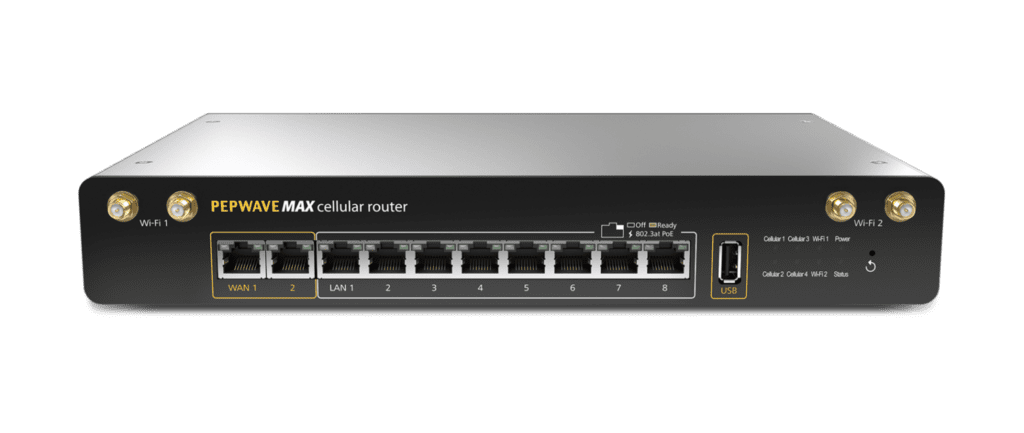
With this router, we can install 4 SIM cards from various carriers right into the router. If one carrier provides exceptionally robust coverage in a certain city, we can double up if we want with say 2 Verizon SIMs, 1 AT&T SIM, and 1 T-Mobile SIM. There are even 2 additional WAN ports to connect external hotspots or hardline connections for an exceptionally robust, near fail-proof internet connection.
To make the final bonding happen between the cellular carriers, you need a bonding service which combines all of the speeds. You pay for the service based on the maximum speed you need. Simply Bonding is a good service that works with the Peplink. Some of the broadcasting software also has it as part of the service.
Mobile Camera Streaming OVER CELLULAR DATA
Like a hardline service, an expensive cellular bonding modem would tie you down to one spot. What if you need to follow the action of a bike race and you can’t be tied down to a router and long SDI cables? Luckily there are solutions to utilize a mobile bonding router.
Among others, one well-known manufacturer, Teradek, makes just that. An addition to a wide array of pro video broadcasting equipment, they offer cellular bonding routers, dedicated robust video encoders/decoders, and cellular radio antennae that all come neatly packaged in a complete and ready-to-go system called the Bond Backpack. There is a space (Gold-Mount or V-Mount) for a high-capacity battery (up to 9 hours of battery life) from Anton Bauer for example. Your camera operator wearing the bag like a typical backpack simply needs to connect the battery, connect their camera via short SDI cable, hit a single power switch, and be on their way – on foot, bicycle, skateboard, scooter, motorcycle, car, train… whatever works!
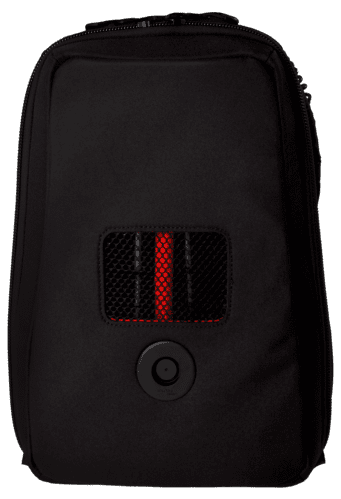


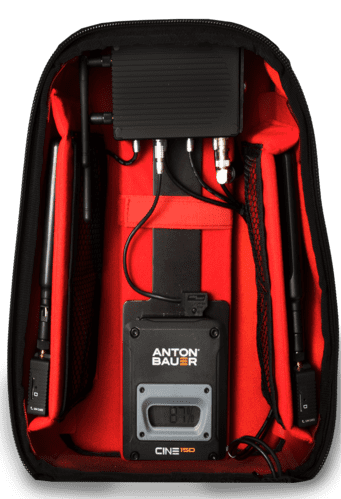
This equipment opens up doors to many different workflows. The backpack itself functions as a video encoder, converting video to data to go out online. You can encode or transmit that signal straight to your end platform (similar to your iPhone straight to Facebook), or you can transmit it to your own decoder (opposite of encoder, this device converts the network data stream to a viewable video signal).
Once you do this, your broadcast possibilities are truly limitless. Allowing your camera operators to focus on the action, their signal can be sent to a studio environment anywhere in the world in near real-time (1-5 seconds).
BEST OF BOTH WORLDS – UTILIZING A STUDIO
Engaging a studio environment means multiple backpacks (or other encoder sources) can be mixed with various other studio inputs, graphics, and videos. This can provide an all-encompassing broadcast environment where you can cover a global range of sources live and rely on the central studio’s controlled environment of specialized network and hardline internet connections to do the final encoding stream to your end platform. If a backpack goes out of coverage for a moment and you happen to lose connection, you don’t lose the entire show. You simply need to go to another source and wait for signal to return.
With the Bond Backpack’s capability of using the HEVC (H.265) video compression codec, a 1080p 60 fps pro video signal could transmit with an impressively low data rate of just 4Mbps!
Requiring such a low data rate has many huge benefits. You can stream from more locations with much more stability, higher quality, and you potentially pay less in data fees.
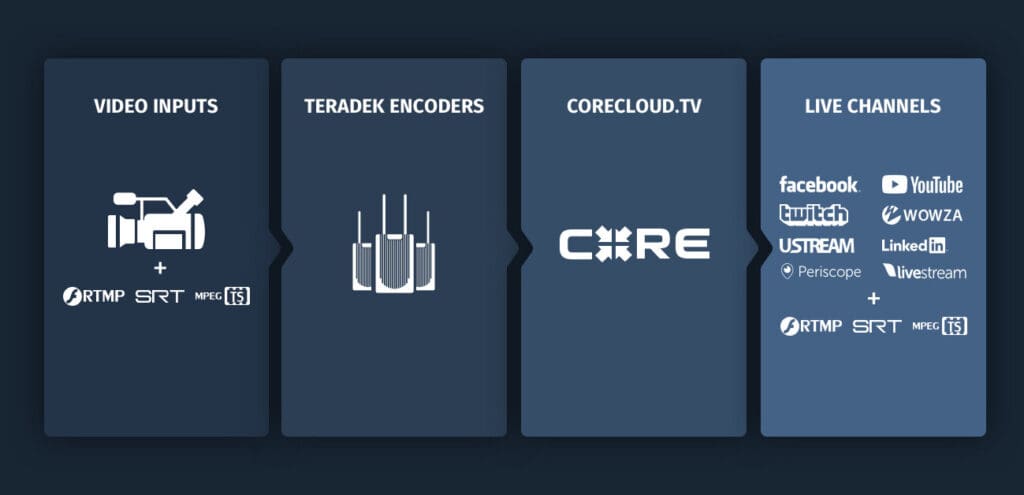
Similar to paying a VPN bonding service for a cellular router like the Peplink mentioned earlier, it’s important to know that to unlock the full potential of the Bond Backpacks you need to invest in paid services through Teradek including their Teradek CORE service, which is their cloud-based control environment. The cloud connections may be hosted through public, readily-available servers, but at this level, it’s definitely worth the additional extra investment for your own dedicated, private server known as a Sputnik that Teradek offers.
ADDITIONAL TIPS WHEN WORKING WITH CELLULAR CONNECTIONS
First of all, there are of course some fees to consider. In order to use a functioning connection with any cellular carrier, you have to have a SIM card tied to an account with paid service. You will be a customer of all the carriers you use and pay a monthly service fee to each for any activated SIM card you own. On top of that, expect the bonding service as mentioned above to be a paid service. Without it, your Pepwave router can still function, but with only one modem at a time which obviously defeats the power and purpose of the device (which the hardware itself can be a bit pricey)
While cell coverage will vary from location to location and from time to time, there are steps you can follow to optimize your cellular connection.
First of all, networking congestion on the cell towers is a real thing you will battle if you are streaming from a particularly crowded event, for example. We’ve found that as a general rule of thumb that if you are expecting more than 2,500 people in your immediate area during the event, unfortunately, there’s not much you can do to ensure flawless streaming on cell networks alone. There are simply too many GSM radios that will cause interference with the communication between your device(s) and the cell tower. Of course, with anything above or below that number, your mileage may vary, but it’s an important factor to keep in mind during your planning stages and setting expectations on cost and quality.
Beyond network congestion, consider the antenna placement of your radios. Ensuring your antennae are installed at the highest elevation possible with clear sight to the sky is by far the best thing you can do. If you need to setup a pole and run some extra cable to make that happen, it is almost always worth it!
UNLOCK YOUR BROADCAST POTENTIAL
Clearly, there are many options for broadcasting a live video from a remote source. Gone are the days of paying thousands upon thousands of dollars for a satellite truck before even considering other operative costs of cameras, labor, travel, permits, etc.
Looking at the most expensive workflows to stream through the most robust cellular connections, you may be looking at some pretty hefty upfront costs for hardware and monthly fees. However, it might be a no-brainer investment for you if you do remote broadcast work often that can pay for itself in no time.
Once you push past the upfront hardware cost, the monthly operating expense is nowhere near comparable to the cost of a satellite truck every single event if you’re simply maintaining a few SIM connections, a bonding service, and perhaps a private cloud Sputnik connection.
What if you don’t want to make that investment yourself?
For starters, have confidence that streaming via mobile hotspot may not be as unrealistic as you might think. For many basic broadcasts, that may be just enough!
If you think your hotspot just won’t cut it, rest assured that we are always here to help. Since we are using these bonded cellular technologies, we won’t have to hire that expensive sat truck and we pass those savings on to you.
If you want to discuss your next event, or just look for some further guidance, please reach out!
P.S. – BCC Live has no affiliation with any of the companies or products mentioned in this article. We simply believe we use some of the best tools in the business and want to share that with you!
